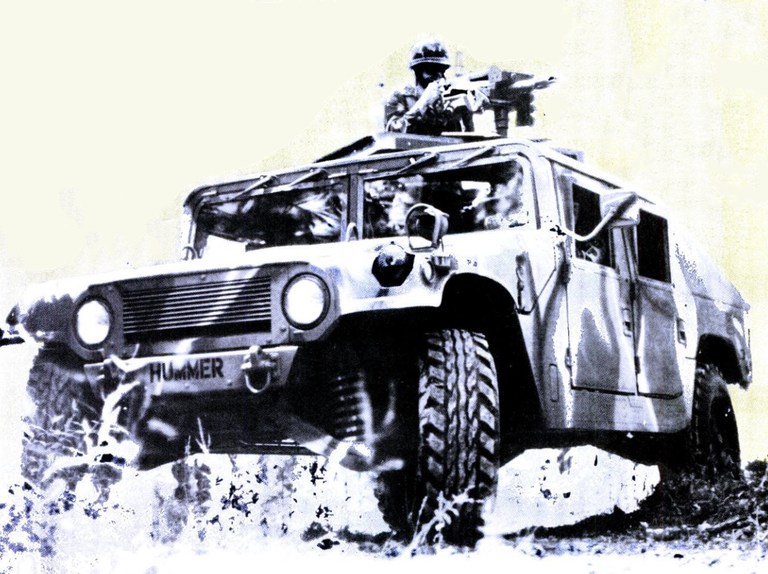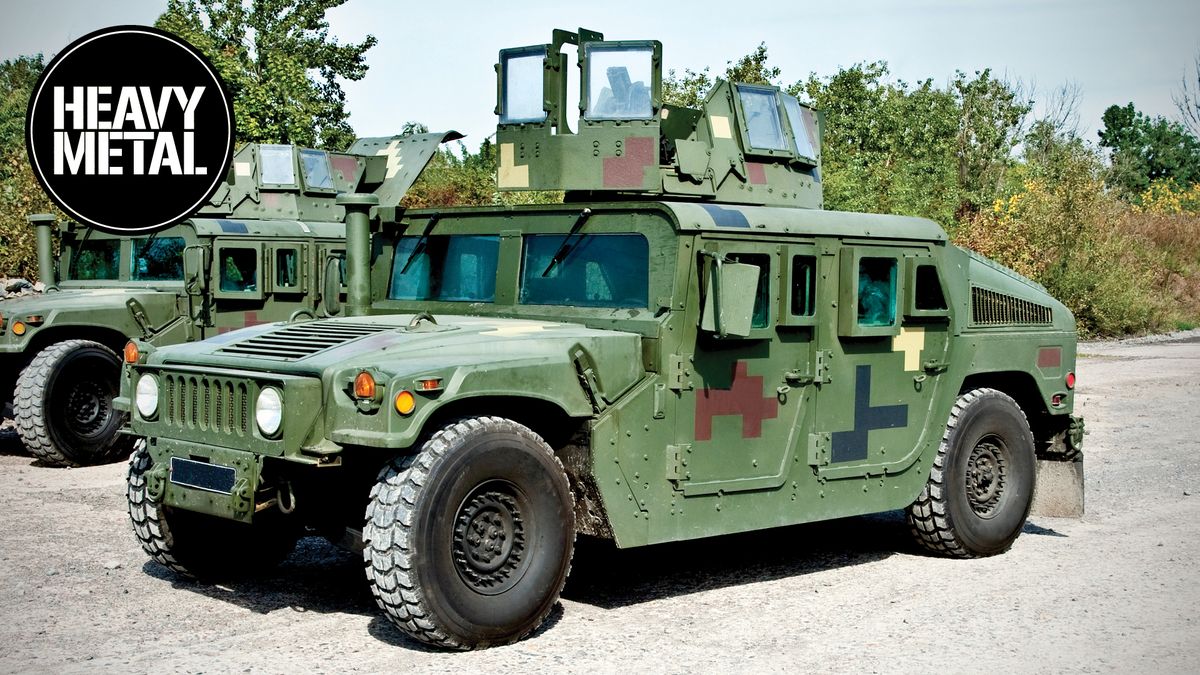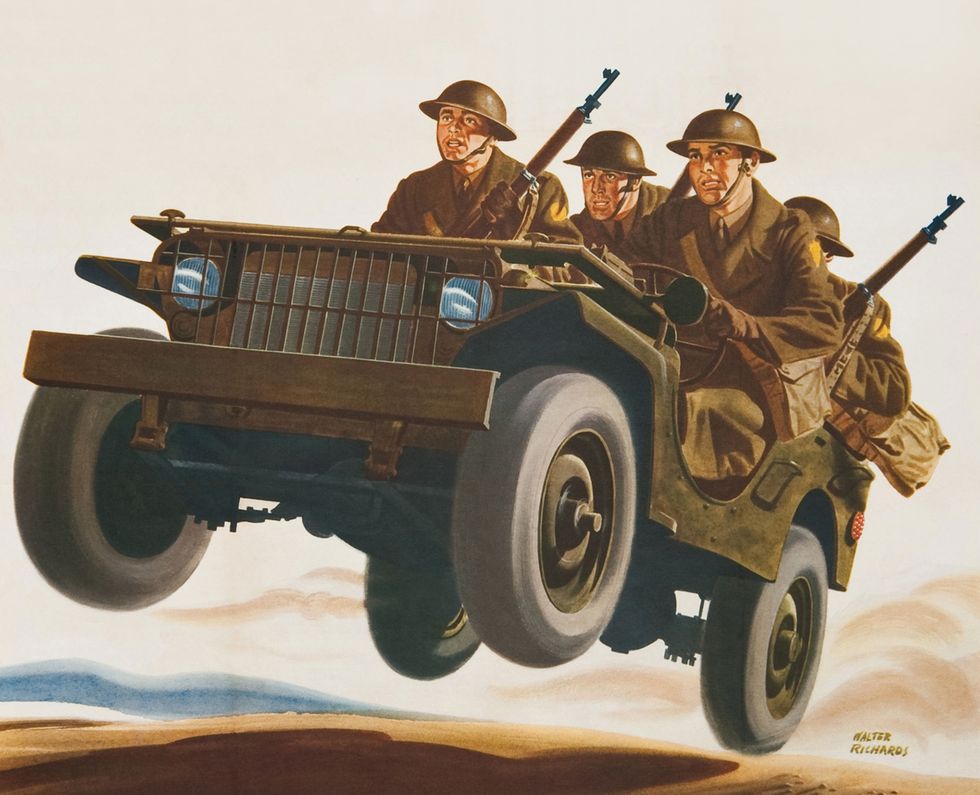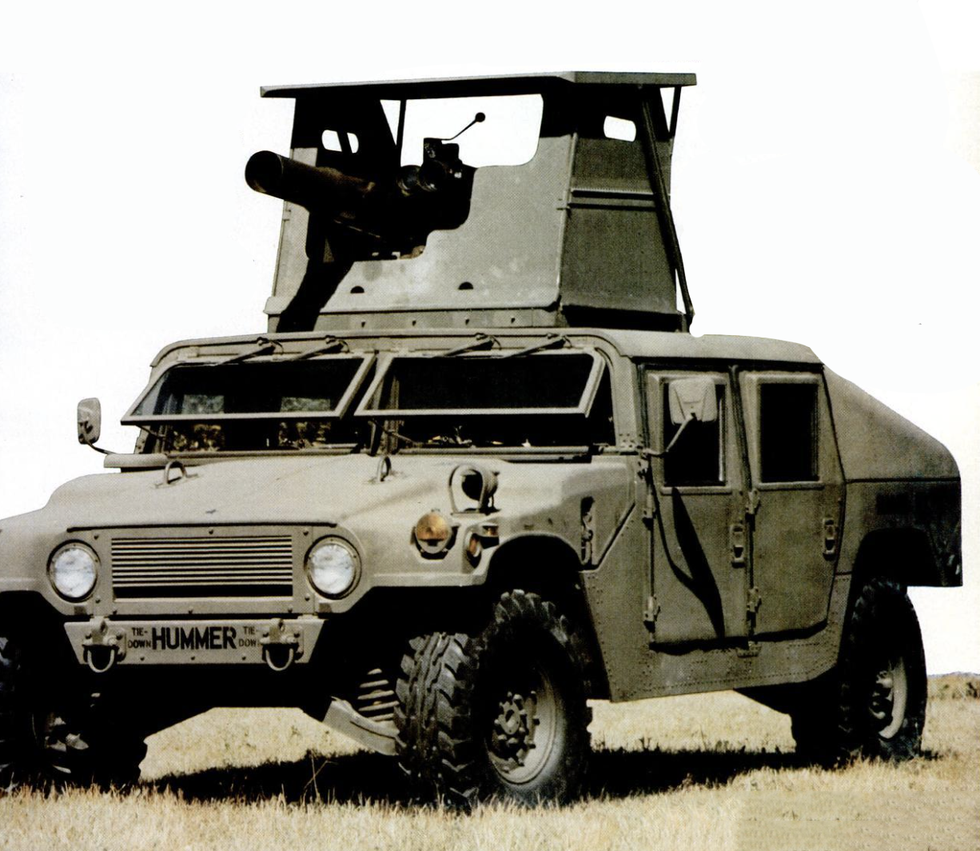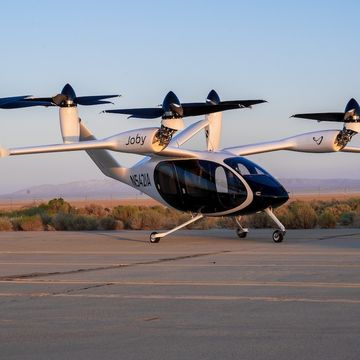In the April 1983 issue, Popular Mechanics followed a certain Army program very closely. Called the High-Mobility, Multipurpose, Wheeled Vehicle, or HMMWV, the program would finally supplant the valiant jeep as the U.S. Army's do-anything vehicle. AM General would eventually be crowned the winner the same month this magazine hit newsstands. Its creation, the Hummer, would go on to serve until this day.
After more than 40 years of faithful service, the historic Army jeep is being retired, put out to pasture. How do you say goodbye to the end of an era, to the last days of an old friend?
Since 1940, the jeep has stood as a symbol of Yankee guts and ingenuity—a runty little battlefield workhorse that was tough, dependable, easy to maintain, seemingly immune to the indignities of war, and ultimately beloved by all it touched, from foot-weary GIs to four-star generals.
Throughout World War II, the vehicle known officially as the M151 14-ton truck served with distinction on every front, in every branch of the armed services, and with every one of our Allies, including the Russians (who loved it, but couldn't quite accept the fact that it was not made in the U.S.S.R.). Later, it soldiered on in Korea, Vietnam, Africa, the Middle East and many other remote and inhospitable outposts far from home. Along the way, it spawned a new breed of rugged, sporty, off-road civilian vehicles—the ubiquitous 4X4s that are popular today the world over.
Now the military jeep is being replaced. But why? If it's been so good for so many years, why get rid of it? The answer lies in the changing needs of war. For its day and purpose, the jeep was unsurpassed. But modern weapons systems have become bigger, heavier and more sophisticated, requiring larger crews to man them and more auxiliary equipment to support them. Handling the TOW missile launcher, for instance, now requires two jeeps and a support trailer.
The TOW (for Tube-launched, Optically tracked, Wire-guided missile) is the most powerful antitank weapon used by the infantry, and a single carrier for it is vitally needed. Other modern-day gear is also straining the little 4X4 beyond its practical limits.
While the jeep has a rated payload capacity of 1,200 pounds, it can actually carry only about 800 pounds when operating cross-country, and then not at top speed. In addition, the current jeep population is getting old. Of the 58,152 now in the Army's inventory, more than 20,000 are over 12 years old, their normal life expectancy. By 1985, more than 40,000—almost all of the present supply—will be nearing the end of their usefulness.
In 1980, faced with these grim prospects, the Army conducted a study of tactical vehicle requirements and concluded that, instead of replenishing its aging jeep fleet with more of the same design, what was really needed was a completely new vehicle. It would be larger, faster and more powerful than the jeep, with a considerably greater payload, more multi-role versatility, increased battlefield mobility and improved combat survivability. Instead of the jeep's relatively light 14-ton rating, it would have a hefty 1/4-ton capacity (sometimes referred to as a 4-ton rating).
The Legendary Jeep: A Hard Act to Follow
The jeep came into being in 1940, born of a need for a new breed of mechanized packhorse that could carry men and messages to the front lines with speed and agility and not necessarily with the benefit of roads. The motorcycles of WWI, with their quaint little sidecars, had proven woefully inadequate in the mud, sand, snow and shell holes that wars are inevitably fought in. It was time for something better.
As in the current competition for the new Humvee, there were three contenders for the jeep title—Ford, American Bantam and Willys-Overland. The Ford and Bantam entries were judged underpowered and Willys emerged the victor (though Ford was given a contract to share the production and some Bantam vehicles were also used).
Officially, the jeep was a command reconnaissance car, but in practice it became whatever an enterprising dog-face could make it. It mounted machine guns, chased tanks with bazookas, ferried troops into battle and the wounded back out, and was occasionally pressed into service to forage for beer.
Although primitive, even by the standards of its own day, it had a 60-hp, fou-cylinder engine, four-wheel drive with synchromesh transmission, high ground clearance and a bone-jarring but virtually unbreakable suspension—a combination that managed to get it most of the places it had to go.
An incredible number of the scrappy little 4X4—more than 600,000—were produced during World War II. They saw action in every theater, from the desert sands of North Africa and the quagmires of Europe to the frozen wastes of Russia and the steamy jungles of Pacific atolls, ultimately jerking and jouncing their way into the hearts of GIs throughout the world.
The origin of the jeep name is still disputed. Some say it came from a comic strip character called Eugene the Jeep, a creature endowed with extraordinary powers. Both Willys and Bantam insisted they coined it, and Willys later commandeered it as a proprietary trade name, spelling it with a capital J. The Army, however, not one to be caught in the crossfire of public controversy, has diplomatically maintained that "jeep" is merely the natural spoken sound for the acronym GP, standing for general-purpose vehicle.
However it got its name, the immortal jeep has been a cherished American legend for more than 40 years. For the fledgling Humvee, it will be a hard act to follow.
The Army's designation for this ambitious new concept is HMMWV (for High-Mobility, Multipurpose, Wheeled Vehicle). The closest you can come to pronouncing this mouthful of consonants is "Humvee," a name not likely to stick once imaginative and irreverent GIs get their hands on the vehicle.
But by whatever name the Humvee will come to be known, its advance notices are impressive. Like the jeep, it will have four-wheel drive, but the similarity stops there. It will be longer than a jeep (195 inches compared to the jeep's 133), yet it will be several inches lower, making it less vulnerable to enemy ground fire. The Humvee will carry a 2,500-pound payload under combat conditions—three times the jeep's capacity. Designed to satisfy a wide range of battlefield requirements, it will also be a multi-service vehicle, serving the requirements of not only the Army, but the Marines and the Air Force, as well.
Using interchangeable body kits, the basic Humvee chassis will be quickly convertible to three different configurations-weapons carrier, utility vehicle and field ambulance. Within these categories, still more variations are possible. Three ambulance versions will carry from four to eight litter patients and in their smaller modes will be readily transportable by helicopter (as will most of the combat support configurations).
In its utility role, the Humvee will haul troops, cargo and communications gear, carry out front-line reconnaissance patrols, function as a mobile command post.
Deadly Firepower
As an attack vehicle, the Humvee will carry a potent mix of weapons ranging from machine guns and grenade launchers to the deadly TOW antitank missile. A clever pop-up gun turret and ballistic-resistant armored shell provide crew protection in combat, allowing it to pursue an enemy far more aggressively than the exposed, open top jeep ever could. It can even mount the Hellfire missile, an advanced, laser-guided antitank weapon, normally air-launched from helicopter gunships, that actually has more range and striking power than the TOW missile system.
The Humvee is so versatile, in fact, that it will eventually replace not only the jeep, but also the 2-ton M274 Mule and the big six-wheel-drive, 1-ton M561 Gama Goat, both, like the jeep, well past their prime. The Humvee will thus take over the roles of three tactical vehicles ranging in capacity all the way from 14 to 1/4 tons. The result will be standardization of parts, reduced maintenance costs, easier battlefield service, and greater operational availability.
Three-Way Competition
To obtain competitive bids for the Humvee, the Army's Tank-Automotive Command (TACOM) selected three prominent manufacturers of military equipment-AMC's AM General Div., maker of both Army jeeps and American Motors' commercial jeep: Teledyne Continental Motors; and General Dynamics, which recently acquired Chrysler Corp.'s prestigious Chrysler Defense Div. Each of the three came up with its own version of the Humvee and submitted 11 prototypes to TACOM for testing and evaluation early last year.
To the victor will go a lucrative contract for the production of as many as 50,000 Humvees over the next five years, with a potential of many thousands more well into the next decade. By the time you read this, the winner should be known, or soon will be. AM General, incidentally, has already coined a name for its entry—it's the Hummer, an eminently more appealing moniker than either Humvee or the unpronounceable HMMWV.
Stiff Army Requirements
Whichever is chosen, all three entries will be basically similar in many respects in order to meet stiff requirements established by the Army. In addition to the capabilities already noted, the new jeep of the future must accelerate from zero to 30 mph in 6 to 8 seconds, maintain a top speed of 60 mph on the highway and 40 mph offroad, climb a 60 percent grade, operate on a 40-percent side slope without slipping or tipping, and have a cruising range of 300 miles. It must be able to climb over obstacles 18 to 22 inches high and ford streams up to 30 inches deep (60 inches deep with an added engine-breather kit).
Automatic Transmission
Unlike the jeep, its successor will have a diesel engine and of all things—an automatic transmission. The latter is not for luxury. The Army's reasoning: Most of today's teenagers have learned to drive in cars with automatic transmissions. An automatic shift Humvee will thus be more familiar and easier to handle, while also saving expensive repairs on certain-to-be-abused manual gearshifts and clutches.
While the jeep depended solely on its agility for survival, the Humvee specs call for ballistic protection from 16-grain fragments traveling at 1,400 ft. sec.—enough to stop some small arms fire and shrapnel. The Humvee will also have an explosion-proof fuel tank and so-called "run-flat" tires designed to provide emergency support even when ruptured.
Despite their enforced similarity, the competing Humvees do differ in some significant and surprising ways. General Dynamics, for instance, is pinning its hopes on an air-cooled diesel, while the other two use liquid cooling. GD's argument: 30 to 40 percent of all engine-related breakdowns in combat are caused by failures in the complex plumbing of a liquid-cooling system. An air-cooled engine, GD claims, would be free of such problems and would operate in temperature extremes from desert heat to arctic cold without supplementary equipment.
The Powerplants
The General Dynamics diesel is a 160-hp, 400-cu.-in. Deutz V8, a German design made in Canada. AM General's Hummer uses a 130-hp, 378-cu.in. V8 diesel from Chevrolet, while Teledyne has adopted International Harvester's 170-hp, 420-cu.-in. V8 diesel.
All three transmissions are stock three-speed automatics with dual-range transfer cases, with one notable difference: Both AM General and General Dynamics have full-time four-wheel drive, while Teledyne's is selective. The two-wheel-drive option, claims Teledyne, improves gas mileage and reduces drive-train wear on good road surfaces where 4WD is not needed. All three manufacturers offer power steering and braking.
The High/Low Problem
While high ground clearance and a low silhouette are both major needs in an off-road combat vehicle, the two obviously work against each other: How do you design a vehicle that's both high and low at the same time? AM General attacks the problem in a novel way.
The wheels on its Hummer are driven at the rim rather than the hub. A ring gear around the rim engages a pinion gear on the axle at the top of the wheel. This means that the axle is 4 inches above the wheel hub, which provides both high ground clearance a full 16 inches and low overall height. The Hummer also has independent coil-spring suspension all around.
Both General Dynamics and Teledyne favor a more conventional layout, contending that the reliability of a proven drive arrangement outweighs the advantages gained through the use of an unorthodox approach. General Dynamics has independent coil-spring suspension in front, but a solid rear axle, maintaining that high ground clearance between axles is more important than clearance between opposing wheels.
Teledyne has independent suspension on all four wheels, controlled by a unique variable-rate torsion-bar system that's designed to provide a soft ride under light loads and a stiffer, more stable ride under heavy loads. Although the manufacturers arrive at it in different ways, all three contenders meet the Army's maximum height allowance of 69 inches, which is 2 inches less than the classic jeep's profile.
More for the Money
Whoever builds it, the new Humvee will cost an estimated $27,000 per copy—not an exorbitant price when you consider all the things it can do compared to its far more primitive predecessor. (Just to replicate the current jeep as it stands would cost a hefty $15,000 per copy.)
While the Humvee may never have an opportunity to match the fame and glory of the immortal World War II jeep, if the vehicle is half as durable and half as well-loved, it could turn out to be a bargain at almost any price.

